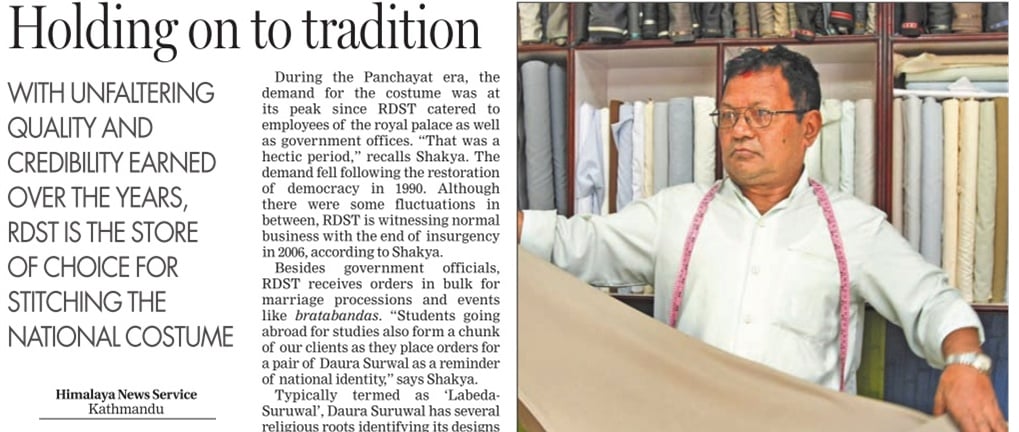Holding on to Tradition
With unfaltering quality and credibility earned over the years, RDST is the store of choice for stitching the national costume.
The Himalayan Times
10/23/20112 min read


Holding on to Tradition: RDST – The Store of Choice for Stitching the National Costume
With unfaltering quality and credibility earned over the years, RDST is the store of choice for stitching the national costume.
Himalaya News Service
Kathmandu
In the sea of modern fashion wear, traditional Daura Suruwal has carved its own secured niche. Besides as a formal dress for civil servants, the outfit is also mostly used in rituals such as marriages and bratabandha (a sacred thread ceremony marking the coming of age for boys in Hindu culture). Rastriya Daura Suruwal Tailors (RDST) in Banepa continues to be a pioneer in stitching the costume.
Hira Bahadur Shakya, founder of RDST says that he has been shouldering the responsibility of reviving the indigenous wear passed on to the rising generations. While his ancestors ran the shop in Patan, he moved it to Kathmandu in 1994. Already in the business for over four decades, Shakya has been working with RDST since he was a teenager.
During the Panchayat era, the demand for the costume was at its peak since RDST catered to employees of the royal palace as well as government officials. “That was a hectic period,” recalls Shakya. The demand fell following the restoration of democracy in 1990. Although there were some fluctuations in between, RDST is witnessing normal business with the end of insurgency in 2006, according to Shakya.
Besides government officials, RDST receives orders in bulk for marriage processions and events like bratabandhas. “Students going abroad for studies also form a chunk of our clients as they place orders for a pair of Daura Suruwal as a reminder of national identity,” says Shakya.
Typically termed as ‘Labeda-Suruwal’, Daura Suruwal has several religious roots identifying its design and has therefore remained the same over the years. The Daura has eight strings on the side to tie itself up around the body. Eight is the lucky number in Nepali mythology. Also, the Daura has five pleats or Kallis, signifying Panchan Buddha or Pancha Ratna. And the closed neck of the Daura signifies the snake around the Lord Shiva’s neck.
However, as with everything else, the making of Daura Suruwal has also changed over time. Shakya recalls that earlier, Daura Suruwals were made solely of homemade fabrics. Currently, the shop uses cotton fabrics produced in Biratnagar besides some imported from India. Daura Suruwals are made for different seasons in different fabric range and bratabandha wear is more in demand. Customers today also prefer Daura Suruwals in dark grey and light grey colours. While people prefer Daura Suruwal made of cotton in the summer, in the winter they opt for the ones made of Vella — a fabric comprising of cotton and wool, according to Shakya.
However, the design of the Daura Suruwal has remained constant for decades, reveals Shakya. Though well-known for Daura Suruwals, the shop also sells accompanying coats and waist coats.
“In the old days, three tailor shops catered to the need for Daura Suruwals. Now the number has increased many folds, but that has not affected our business at all,” claims Shakya. Shakya says that the trust earned over the years is credible enough to run the business. The shop has been maintaining its standard through utmost care of stitching and finishing of its products besides timely delivery.
Boasting about the legacy of his shop, Shakya says, “Kaji Sherpa scaled Mount Everest wearing our Daura Suruwal.” Against the influx of modern wear, Shakya is confident that the Daura Suruwal will continue to hold its ground even in the days ahead.
Although many businesses are facing major problems due to labour issues, he says he has never had to deal with such issues in the shop, which employs altogether ten employees at present.
Nepali Poshak
Explore the beauty of Nepali dress and accessories.
Contact us
© 2025. All rights reserved.
Quick links
